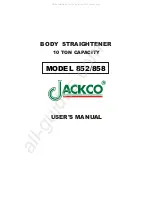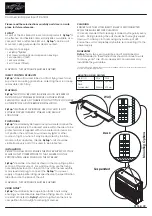
FR
INSTALLATION OF THE DEVICE
1. Attach connector for rope length adjuster
to one side attachment buckle of a work
positioning belt compliant with EN 358. Put
the rope around a construction element
and attach the connector to the other side
attachment buckle – Fig. 1. Construction
element should be located at the height of
user's waist or above. Shape and
construction of construction element shall
not allow for a self-acting disconnection of
the device. Minimal static strength of the
element should be 12kN. Rope of the
device should be protected with
to prevent damage of the rope when
in contact with abrasive surface or sharp
edges of the element around which it is
routed – Fig. 1a).
2. The device can be attached to
attachment buckle of a sit harness
compliant with EN 813 or a single D-ring of
a work positioning belt – Fig. 2. Attach
connector for rope length adjuster to
attachment buckle of a harness, and rope
connector to anchor point located at the
height of user's waist or above. Shape and
construction of anchor point must not allow
for a self-acting disconnection of the
device. Minimal static strength of anchor
point should be 12kN.
3.
a) Lengthening the rope
adjuster
– Fig. 3.
Deflect from the construction to tension
and lengthen the rope. Release the
o
lock of the rope and stop its lengthening.
b) Shortening the rope
Pull the rope free end towards the
construction by inclining in this direction –
Fig. 4
NOTE: Before and during operation, check
whether individual attachment elements
are connected properly. Connectors must
be closed and protected against accidental
opening by locking gear.
protective
sleeve
Unlock the adjuster by pressing
lever
lever t
Using the rope adjuster, adjust the length
and the tension of the rope to assure a stable
work position and restrict the free fall of the
worker. The lanyard must be kept taut during
use.
1
1a
2
4
THE ESSENTIAL PRINCIPLES FOR USERS OF PERSONAL PROTECTIVE EQUIPMENT AGAINST FALLS FROM A HEIGHT:
personal protective equipment shall only be used by a person trained and competent in its safe use.
personal protective equipment must not be used by a person with medical condition that could affect the safety of the
equipment user in normal and emergency use.
a rescue plan shall be in place to deal with any emergencies that could arise during the work.
being suspended in PPE (e.g. arresting a fall), beware of suspension trauma symptoms.
to avoid symptoms of suspension trauma, be sure that the proper rescue plan is ready for use. It is recommended to use
foot straps.
it is forbidden to make any alterations or additions to the equipment without the manufacturer's prior written consent.
any repair shall only be carried out by equipment manufacturer or his certified representative.
personal protective equipment shall not be used outside its limitations, or for any purpose other than that for which it is
intended.
personal protective equipment should be a personal issue item.
before use ensure about the compatibility of items of equipment assembled into a fall arrest system. Periodically check
connecting and adjusting of the equipment components to avoid accidental loosening or disconnecting of the components.
it is forbidden to use combinations of items of equipment in which the safe function of any one item is affected by or
interferes with the safe function of another.
before each use of personal protective equipment it is obligatory to carry out a pre-use check of the equipment, to ensure
that it is in a serviceable condition and operates correctly before it is used.
during pre-use check it is necessary to inspect all elements of the equipment in respect of any damages, excessive wear,
corrosion, abrasion, cutting or incorrect acting, especially take into consideration:
in full body harnesses and belts - buckles, adjusting elements, attaching points, webbings, seams, loops;
in energy absorbers - attaching loops, webbing, seams, casing, connectors;
in textile lanyards or lifelines or guidelines - rope, loops, thimbles, connectors, adjusting element, splices;
in steel lanyards or lifelines or guidelines - cable, wires, clips, ferrules, loops, thimbles, connectors, adjusting elements;
in retractable fall arresters - cable or webbing, retractor and brake proper acting, casing, energy absorber, connector;
in guided type fall arresters - body of the fall arrester, sliding function, locking gear acting, rivets and screws, connector,
energy absorber;
in metalic components (connectors, hooks, anchors) - main body, rivets, gate, locking gear acting.
after every 12 months of utilization, personal protective equipment must be withdrawn from use to carry out periodical
detailed inspection. The periodic inspection must be carried out by a competent person for periodic inspection. The periodic
inspection can be carried out also by the manufacturer or his authorized representative.
in case of some types of the complex equipment e.g. some types of retractable fall arresters the annual inspection can be
carried out only by the manufacturer or his authorized representative.
regular periodic inspections are the essential for equipment maintenance and the safety of the users which depends upon
the continued efficiency and durability of the equipment.
during periodic inspection it is necessary to check the legibility of the equipment marking. Don’t use the equipment with the
illegible marking.
it is essential for the safety of the user that if the product is re-sold outside the original country of destination the reseller
shall provide instructions for use, for maintenance, for periodic examination and for repair in language of the country in which the
product is to be used.
personal protective equipment must be withdrawn from use immediately when any doubt arise about its condition for safe
use and not used again until confirmed in writing by equipment manufacturer or his representative after carried out the detailed
inspection.
personal protective equipment must be withdrawn from use immediately and destroyed (or another procedures shall be
introduced according detailed instruction from equipment manual) when it have been used to arrest a fall.
a full body harness (conforming to EN 361) is the only acceptable body holding device that can be used, in a fall arrest
system.
in full body harness use only attachment points marked with a capital letter "A" to attach a fall arrest system.
the anchor device or anchor point for the fall arrest system should always be positioned, and the work carried out in such a
way, as to minimise both the potential for falls and potential fall distance. The anchor device/point should be placed above the
position of the user . The shape and construction of the anchor device/point shall not allowed to self-acting disconnection of the
equipment. Minimal static strength of the anchor device/point is 12 kN. It is recommended to use certified and marked structural
anchor point complied with EN795
it is obligatory to verify the free space required beneath the user at the workplace before each occasion of use the fall arrest
system, so that, in the case of a fall, there will be no collision with the ground or other obstacle in the fall path. The required value
of the free space should be taken from instruction manual of used equipment.
there are many hazards that may affect the performance of the equipment and corresponding safety precautions that have
to be observed during equipment utilization, especially: - trailing or looping of lanyards or lifelines over sharp edges, - any defects
like cutting, abrasion, corrosion, - climatic exposure, - pendulum falls, - extremes of temperature, - chemical reagents, - electrical
conductivity.
-
-
-
-
-
-
-
3
MISE EN PLACE DU DISPOSITIF
1. Accrochez le connecteur du dispositif de réglage de la corde à la
boucle d’attelage sur un côté de la ceinture de maintien au travail
conforme à la norme EN 358. Passez la corde autour d’un élément
de construction et accrochez le connecteur à la boucle d’attelage
se trouvant sur l’autre côté – Fig. 1. L’élément de construction doit
se trouver au niveau de la taille de l’utilisateur ou plus haut. La
forme et la structure de l’élément de construction doit empêcher la
déconnexion spontanée du dispositif. La force statique de l’éléme-
nt doit s’élever à au moins 12kN. La corde du dispositif doit être
protégée à l’aide d’une gaine de protection, afin de prévenir tout
dommage que pourrait causer à la corde le contact avec une sur-
face abrasive ou des bords tranchants de l’élément autour duquel
elle est passée – Fig. 1a).
2. Le dispositif peut être attelé à la boucle d’attelage d’une cein-
ture à cuissardes conforme à la norme EN 813 ou un seul anneau
en D d’une ceinture de maintien au travail – Fig. 2. Accrochez le
connecteur du dispositif de réglage de la longueur de la corde à
la boucle d’attelage du harnais, et le connecteur de la corde à un
point d’ancrage situé au niveau de la taille de l’utilisateur ou plus
haut. La forme et la structure du point d’ancrage doit empêcher
la déconnexion spontanée du dispositif. La force statique du point
d’ancrage doit s’élever à au moins 12kN.
3. À l’aide du dispositif de réglage de la corde ajustez la longueur et
la tension de la corde, afin d’assurer une position de travail stable
et limiter la chute libre de l’utilisateur. La longe doit rester tendue
pendant son usage.
a) Allongement de la corde
Déverrouillez le dispositif de réglage en appuyant sur le levier – Fig. 3.
Déviez de la structure pour allonger la corde et la tendre. Relâchez la manivelle pour bloquer la corde
et arrêter son allongement.
b) Raccourcissement de la corde
Tirez l’extrémité libre de la corde vers la construction en l’inclinant dans cette direction – Fig. 4.
N.B. : Avant et pendant l’opération, vérifiez si les différents éléments de connexion sont reliés de
manière appropriée. Les connecteurs doivent être fermés et protégés contre l’ouverture accidentelle
à l’aide de dispositifs de verrouillage.
PRINCIPES DE BASE POUR LES UTILISATEURS D’ÉQUIPEMENTS DE PROTECTION CONTRE LES
CHUTES DE HAUTEUR
• l’équipement de protection individuelle doit être utilisé uniquement par des personnes compétentes
et formées en la matière.
• l’équipement de protection individuelle ne doit pas être utilisé par des personnes souffrant de
maladies pouvant affecter la sécurité
de l’utilisateur en conditions normales ou en conditions d’urgence.
• un plan de sauvetage doit être mis en place pour pouvoir faire face à d’éventuelles urgences qui
pourraient se produire dans le cadre du travail.
• lors de la suspension en équipement de protection individuelle (ex. lorsqu’il a servi à arrêter une
chute), faites attention aux symptômes liés aux traumatismes causés par la suspension.
• pour éviter les traumatismes causés par la suspension, assurez-vous qu’un plan de sauvetage
approprié est prêt à être utilisé. Il est recommandé d’utiliser des sangles pour pieds.
Содержание 27956
Страница 27: ...NOTE...














































